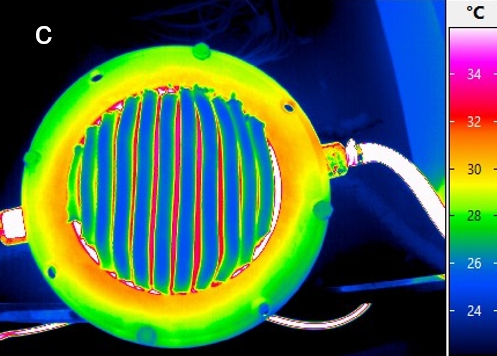Thermodynamic qualification of knitted spacer fabrics for use as insulation box insert in the context of refrigerated transport containers in the logistics sector
DOI:
https://doi.org/10.25367/cdatp.2023.4.p18-26Keywords:
spacer fabrics, transport box, cold chain, thermal insulation, foldable box, logistics container, knitted fabric, structure design, thermal conductivity, knitted box, sustainability, energy efficiency, temperature-sensitive goods, knitted spacer fabric, logisticsAbstract
Temperature-sensitive products such as refrigerated and frozen goods pose particular challenges for logistics. Against the background of the mobility shift towards electric vehicles and the current challenges of temperature-stable transport in the field of pharmaceutical, esp. vaccine logistics in the context of the SARS-CoV-2 pandemic, new, energy-efficient vehicle equipment is needed to maintain cold chains. Known refrigeration concepts are designed to cool the entire cargo hold. In addition, the goods cannot be removed from the vehicle while maintaining the cold chain. An insulating effect of containers is typically achieved by using foamed polystyrene (Styrofoam). On the one hand, these structures have a very good insulating effect, but on the other hand, they cannot be reduced in volume during recirculation and are problematic with regard to recycling. The aim of the research presented here is therefore to develop a knitted box that is designed as a volume-reducible, rigid but foldable box. This can be used as a supplement to existing transport container systems and therefore can be inserted in the transport container. The knitted box performs as insulation when the transported goods are actively cooled inside the box, which is more sustainable and flexible than recent insulation solutions. Knitted fabrics, especially spacer fabrics, have advantageous thermo-physical properties for this application due to their structural design. In the course of a research project, various spacer fabrics were tested for their thermo-physical suitability as insulation materials. It was found that knitted predetermined folding lines represent an insulation gap. Based on this, a new structure was developed which, due to its structural design, compensates for cold or thermal bridges at vertices and edges of the box. The results show that the knitted corrugated structure insulates better than the knitted spacer fabrics with predetermined folding lines. A thermal imaging camera was used to identify critical points for heat transfer.
References
Ogulata, R.T.; Mavruz, S. Investigation of porosity and air permeability values of plain knitted fabrics. FIBERS & TEXTILES in Eastern Europe 2010, 18(5), 71-75.
Cooke, B. The physical properties of weft knitted structures. In Advances in knitting technology, Au, K.F., Ed.; Woodhead Publishing Limited Cambridge, 2011.
Mecheels, J. Körper, Klima, Kleidung, Wie funktioniert unsere Kleidung? Schiele & Schon GmbH, Berlin, 1998.
Grundmeier, A.-M. Bekleidung und Gesundheit, Ein Kompendium mit ausgewählten Aspekten. Schneider Verlag Hohengehren, Baltmannsweiler, 2015.
DIN Deutsches Institut für Normung e. V, DIN 60022-1:2020, Abstandstextilien Begriffe und Proben-vorbereitung. November 2020.
DIN Deutsches Institut für Normung e. V, DIN 60022-3:2022, Abstandstextilien Teil 3: Bestimmung der Dicke. February 2022.
Cooke, B. The physical properties of weft knitted structures. In Advances in knitting technology, Au, K.F., Ed., Woodhead Publishing Limited Cambridge, 2011.
Van Neerven, O. et al. Textile, volumenreduzierbare und wiederverwendbare Transportbox für die elektro- mobile, temperaturbezogene Pharma- und Impfstofflogistik – Smart Matter. Antrag zum FuE- Kooperationsprojekt, 2021.
Walther Faltsysteme GmbH. Online: https://faltbox.com/de/loesungen/branchenloesungen/retail/non-food-distributionsboxen-fuer-den-leh/ (accessed 2022-08-23)
Chung, S.; Ehrmann, A.; Weber, M.O. Genauigkeit von Dickenmessungen an Maschenwaren. In Melliand Textilberichte 2012, 93(4), 198-199.
DIN Deutsches Institut für Normung e. V. EN ISO 5084:1996, Bestimmung der Dicke von Textilien und textilen Erzeugnissen. October 1996.
DIN Deutsches Institut für Normung e. V. EN ISO 12127:1997, Textile Flächengebilde – Bestimmung der flächenbezogenen Masse unter Verwendung kleiner Proben. October 1997.
DIN Deutsches Institut für Normung e. V. EN ISO 11092:2014, Physiologische Wirkungen – Messung des Wärme- und Wasserdampfdurchgangswiderstands unter stationären Bedingungen (sweating guarded-hotplate test). Berlin, September 2014.
Huang, J. Sweating guarded hot plate test method. Polymer Testing 2006, 25, 709-716.
Güther, D. personal communication from 2022-02-28.
Freitag, T. Entwicklung eines Natriumacetat-Trihydrat-Latentwärmespeichers mit einem Wärmeüberträger aus Kunststoffmetallverbund-Kapillarrohr. PhD thesis, Technical University Chemnitz, Chemnitz, Germany, 2005.
DIN Deutsches Institut für Normung e. V. DIN 52616:1977-11, Wärmeschutztechnische Prüfungen; Bestimmung der Wärmeleitfähigkeit mit dem Wärmestrommessplatten-Gerät. November 1977.

Downloads
Published
How to Cite
Issue
Section
License
Copyright (c) 2023 Julia Klausmann, Thomas Mutschler, Prisca Holderied, Dominik Güther, Thomas Freitag, Matthias Hummel, Martin Zeitler, Oliver van Neerven, Marcus Oliver Weber, Christoph Breckenfelder

This work is licensed under a Creative Commons Attribution-NonCommercial-NoDerivatives 4.0 International License.





